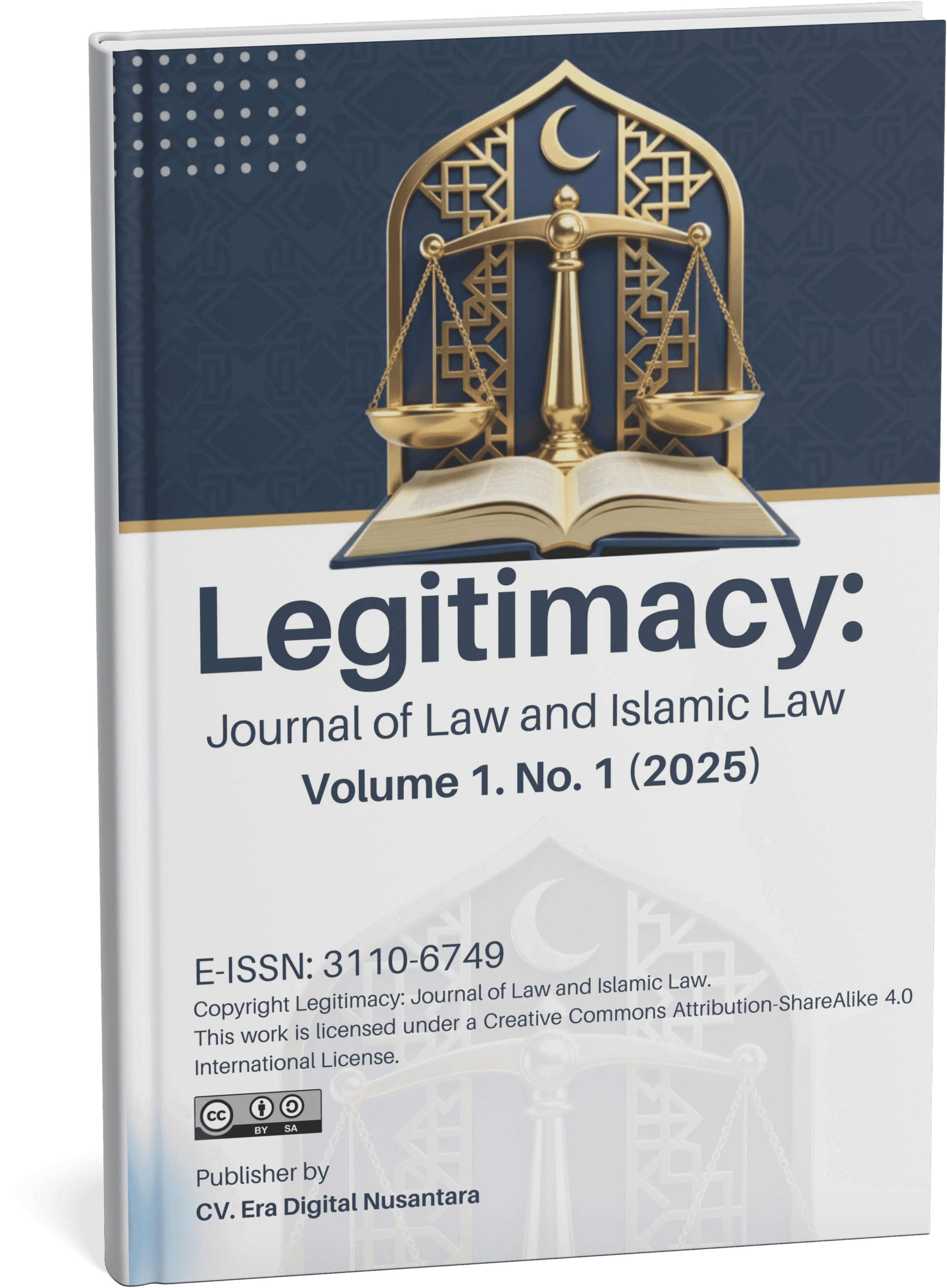Childfree Marriages in Islamic Perspective: A Maqāṣid al-Sharīʿah Analysis of Spousal Choice and Reproductive Intentions
Main Article Content
Abstract
The contemporary rise of intentional childfree unions has sparked scholarly debate on the compatibility of spouse-driven reproductive decisions with Islamic legal objectives. This study examines the phenomenon of childfree marriage through the theoretical lens of Maqāṣid al-Sharīʿah as articulated by al-Ṣāṭibī, focusing on the protection of progeny (ḥifẓ al-nasl) among the five foundational objectives. Employing a qualitative literature review of Indonesian and international sources, this article maps the socio-cultural factors economic considerations, career priorities, health constraints, and ethical concerns that motivate couples to forgo parenthood. It then assesses how these motivations align or conflict with the sharīʿah’s hierarchical categories of necessities (darūriyyāt), needs (ḥājiyyāt), and refinements (taḥsīniyyāt). A critical analysis of classical and contemporary Islamic juridical opinions on contraception, ‘azl (coitus interruptus), and permanent sterilization elucidates the juristic reasoning that permits or prohibits reproductive control measures. The study further explores Fatwa decisions by the Indonesian Ulema Council (MUI) from 1979 to 2012, highlighting shifts in permissibility under exigent circumstances. Findings reveal that while temporary child spacing aligns with secondary objectives (ḥājiyyāt) when safeguarding maternal health, permanent childfree choices conflict with primary objectives (darūriyyāt) unless justified by compelling necessity. The article concludes by proposing a nuanced legal framework that upholds spousal autonomy and welfare while preserving the maqāṣid’s commitment to lineage continuity. Recommendations call for dynamic fiqh responses that balance individual rights with communal interests in sustaining Muslim ummah growth.
Article Details

This work is licensed under a Creative Commons Attribution-ShareAlike 4.0 International License.
References
A. Saputra, I. Muslim, B. Yuniarto, and A. Mulyana, “Analisis Literatur Sosiologi Keluarga Sakinah dalam Kewajiban Mendidik Anak Usia Dini,” J. Pelita PAUD, vol. 6, no. 2, pp. 293–300, Jun. 2022, doi: 10.33222/pelitapaud.v6i2.1972.
I. H. Hapsari and S. R. Srptiani, “Kebermaknaan Hidup pada Wanita yang Belum Memiliki Anak Tanpa Disengaja (Involuntary Childless),” JPPP - J. Penelit. dan Pengukuran Psikol., vol. 4, no. 2, pp. 90–100, Oct. 2015, doi: 10.21009/JPPP.042.07.
R. Rustina, “Keluarga dalam kajian Sosiologi,” Musawa J. Gend. Stud., vol. 14, no. 2, pp. 244–267, Dec. 2022, doi: 10.24239/msw.v14i2.1430.
A. Blackstone, “Childless… or Childfree?,” Contexts, vol. 13, no. 4, pp. 68–70, Nov. 2014, doi: 10.1177/1536504214558221.
S. Weaver, “More Americans are choosing to live a childfree life, study finds,” Live Now Fox. [Online]. Available: https://www.livenowfox.com/news/more-americans-choosing-live-childfree-life-study
Y. S. H. Hasyim and N. Susfita, “Tinjauan hukum keluarga Islam tentang fenomena childfree dan pengaruhnya terhadap ketahanan keluarga,” Mahkamah J. Kaji. Huk. Islam, vol. 8, no. 1, p. 54, May 2023, doi: 10.24235/mahkamah.v8i1.13068.
S. Yessino, D. M. Sulaiman, and A. Fadhil, “Analisis Fenomena Childfree di Era Gen Z terhadap Syariat dan Realitas Modern,” Karakter J. Ris. Ilmu Pendidik. Islam, vol. 2, no. 2, pp. 79–89, Dec. 2024, doi: 10.61132/karakter.v2i2.526.
I. Harahap, F. A. Siregar, and E. Hariyanto, “Understanding The Rise of Childfree Marriage: Avoiding Toxic Family, Being Happy and Well Without Children Despite Contradiction With Maqashid al-Sharia,” Al-Istinbath J. Huk. Islam, vol. 10, no. 1, pp. 303–329, Apr. 2025, doi: 10.29240/jhi.v10i1.9984.
K. U. Addzaky, Taufiqurohman, and M. Asy’ari, “Deconstruction of Hifdzun Nasl in Maqasid Syari’ah: Analysis of the Childfree Phenomenon from the Perspective of Islamic Family Law,” RIGHT J. Agama dan Hak Azazi Mns., vol. 14, no. 1, pp. 11–133, 2025, doi: 10.14421/9xrnrr95.
Z. Arifin and Z. Mahmudi, “Mandatory Wills for Adultery Children, Analysis of the Compilation of Islamic Law from the Perspective of Maqasid Syariah Al-Syatibi,” Int. J. Law Soc., vol. 1, no. 1, pp. 36–47, Jan. 2022, doi: 10.59683/ijls.v1i1.4.
T. Parsons, “The Present Status of ‘Structural-Functional’ Theory in Sociology,” in The Idea of Social Structure, Routledge, 1975, pp. 67–84. doi: 10.4324/9781315132563-5.
U. Beck, “Interview with Ulrich Beck,” J. Consum. Cult., vol. 1, no. 2, pp. 261–277, Jul. 2001, doi: 10.1177/146954050100100209.
A. I. Mawardi, Maqâsid al-syarî’ah dalam Pembaharuan Fiqh Pernikahan di Indonesia. Surabaya: Pustaka Radja, 2018.
Bagus Ary Darmawan, M. Reza Saputra, and Jaenal Aripin, “Analisis Hak Asuh Anak Dalam Putusan Pengadilan Agama Lahat Nomor 685/Pdt.G/2022/PA.LT: Perspektif Maqâsid Al-Syarî’ah Muhammad Thâhir Ibn Âsyûr,” Konsensus J. Ilmu Pertahanan, Huk. dan Ilmu Komun., vol. 1, no. 4, pp. 319–335, Jul. 2024, doi: 10.62383/konsensus.v1i4.297.
M. R. Saputra, “Model Pegawasan Penyelenggara Pemilu Di Indonesia Persepktif Maqâsid Al-Syarî’ah Jâsir ‘Audah,” Universitas Islam Negeri Syarif Hidayatullah Jakarta, 2022.
M. Djawas, M. Misran, and C. P. Ujong, “‘Azl Sebagai Pencegah Kehamilan (Studi Perbandingan Antara Mazhab Hanafi dan Mazhab Syafi’i),” El-USRAH J. Huk. Kel., vol. 2, no. 2, p. 234, Aug. 2020, doi: 10.22373/ujhk.v2i2.7657.
M. N. Hanasir and S. Supardin, “Penggunaan Kontrasepsi Vasektomi Dalam Pandangan Hukum Islam,” Qadauna J. Ilm. Mhs. Huk. Kel. Islam, vol. 1, no. 2, pp. 60–71, Apr. 2020, doi: 10.24252/qadauna.v1i2.12784.
Majelis Ulama Indonesia, Himpunan fatwa MUI sejak 1975. Jakarta: Emir, 2015.
R. Adi and A. Afandi, “Analisis Childfree Choice Dalam Perspektif Ulama’ Klasik dan Ulama’ Kontemporer,” TARUNALAW J. Law Syariah, vol. 1, no. 01, pp. 78–87, Jan. 2023, doi: 10.54298/tarunalaw.v1i01.73.
A. Mascarenhas, “Millions unable to realise reproductive goals’: UNFPA State of World Population Report 2025 reveals crisis of fertility aspirations,” Indian Express. [Online]. Available: https://indianexpress.com/article/cities/pune/reproductive-goals-unfpa-state-of-world-population-report-2025-crisis-fertility-aspirations-10058042/
R. A. M. Ismail, “The Childfree Trend: Regional Perspectives, Socioeconomic Impacts, and Policy Responses,” 2025.
T. Sobotka, “Un tiers des femmes d‘Asie de l’Est resteront sans enfant,” Popul. Sociétés, vol. N° 595, no. 11, pp. 1–4, Dec. 2021, doi: 10.3917/popsoc.595.0001.
I. Szalma, M. Heers, and M. L. Tanturri, “Measuring attitudes towards voluntary childlessness: Indicators in European comparative surveys,” PLoS One, vol. 20, no. 3, p. e0319081, Mar. 2025, doi: 10.1371/journal.pone.0319081.
S. Khafid and Sunartono, “Puluhan Ribu Perempuan Indonesia Memilih Childfree,” Harian Jogja. [Online]. Available: https://leisure.harianjogja.com/read/2024/11/21/508/1195282/puluhan-ribu-perempuan-indonesia-memilih-childfree

